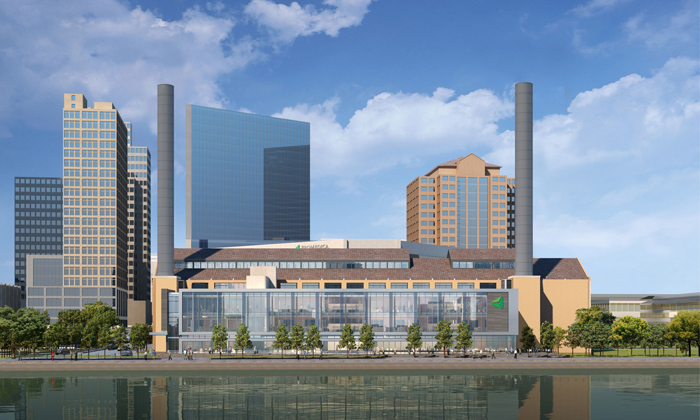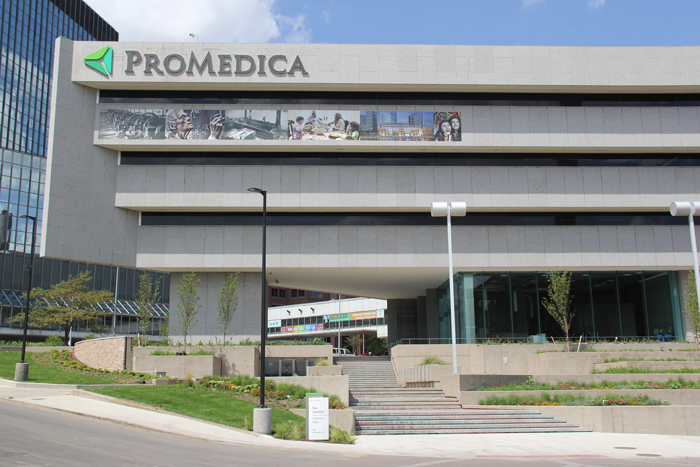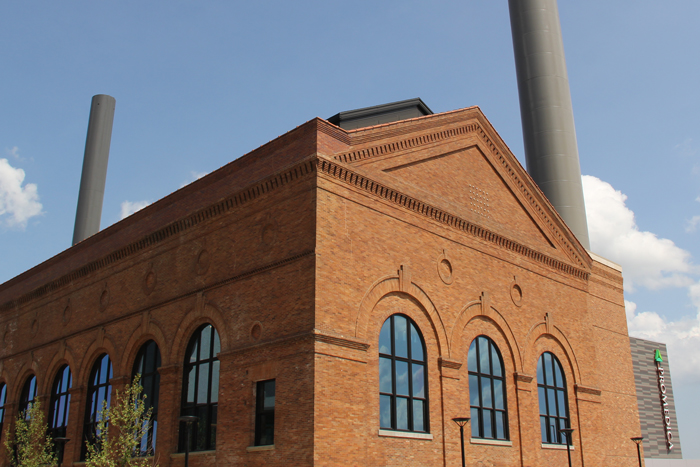As published in Manufacturing & Construction News - September 1, 2017

Rendering of ProMedica’s headquarters in downtown Toledo
ProMedica invests $62.5M+ in downtown Toledo HQ
ProMedica, a locally-owned, non-profit health system providing healthcare services to 27 counties in northwest Ohio and southeast Michigan, has invested over $62.5 million to relocate its corporate headquarters to downtown Toledo.
The new headquarters, which is 260,000 square feet in total, will include the former Toledo Edison Water Street Station, commonly known as the Steam Plant, the former KeyBank building, now called the Junction, and a new parking garage, called the Depot. According to ProMedica, it is expected to consolidate around 1,000 of its employees to this new location and to help serve as a catalyst to further revitalize the downtown area.
Robin Whitney, senior vice president of real estate and construction for ProMedica, stated, “What we needed to do was consolidate people from many of our operations. We had grown over time and had people in several different buildings throughout northwest Ohio and southeast Michigan, so it was important to really consolidate our employees into one location to create a better environment, build teamwork, and become more efficient. So we evaluated, tried to do a greenfield project, considered whether we could try to consolidate near one of our hospital campuses, and then we decided we really wanted to look for something in downtown Toledo because we hoped that not only would it serve our internal needs to consolidate our employees, but it could serve as a catalytic project for revitalization of downtown. So that’s really what made our decision to really look downtown; we felt like we were getting double-benefits: the consolidation that we needed for our own employees plus the revitalization for downtown.”
Construction on the project began in October 2015 and was completed in late August. HKS Architects, of Northville, Michigan, designed the project and Rudolph Libbe Inc., of the Rudolph Libbe Group, was the construction manager.
When speaking of the renovations, Brian Lamerson, senior project manager for Rudolph Libbe, said, “The project involved historical preservation and renovations to the former Toledo Edison Water Street Station, also known as the Steam Plant, and was completed in late August. The Steam Plant was built in the late 1800s with two 55-foot smokestack masonry pedestals, each supporting a 160-foot steel stack. ProMedica officials hoped to preserve the two smokestacks, which had towered above the Steam Plant for more than a century, but ultimately, the original stacks were dismantled and removed due to structural concerns. The stacks were rebuilt and replaced with steel replicas about 2 feet smaller in diameter and approximately 20 feet shorter. The Steam Plant’s open ceiling design displays a 19th-century overhead crane supported on the original crane rail. A three-story addition was constructed between the smokestacks overlooking the river.

The Junction building of ProMedica’s headquarters
“The interior remodeling of the KeyBank building, The Junction, was completed in early August 2017 and involved the interior remodel of the entire building consisting of a YMCA in the basement, Barry Bagels and the Chop House on the ground floor, and office space on the top 3 floors.
“The Depot is a separate project not part of the Junction and it consisted of a six-story, above-grade, pre-cast parking garage with 637 parking spaces (one story below grade with 123 parking spaces) and a 5,000-square-foot tenant suite. The parking garage was completed in early June,” added Lamerson.
Whitney said, “What’s really amazing about the Steam Plant is we’ve been able to put an absolutely new, cutting-edge design for office space into an historic structure, and you’re able to see both. In the Steam Plant, at the far south end of the building, you can see all the way up to the roof structure. There’s kind of a 4-story atrium that looks like a steam plant. We didn’t try to hide anything. We kept as much of the exposed brick walls, even if they didn’t look perfect, and left them looking as is so you would never mistake that this was a steam plant. Then, there is a bridge crane that spans the entire width of the Steam Plant that would move back and forth to move the turbine engines and things like that. Well, we took one of those bridge cranes and put it in that four-story space. So now, if you look up, you’ll see that bridge crane. There’s also very beautiful arch windows in that steam plant that needed to be replaced, so we put new windows that look identical to what was in there back in the 1880s when it was constructed. It looks great.”

The renovated Steam Plant of ProMedica HQ
The Steam Plant received an historic tax credit and had to have the Historic Preservation Office and National Park Service involved during renovations. According to Whitney, the groups wanted ProMedica to reuse brick and to preserve the building as much as possible.
“They were very strict on what we could and couldn’t do to the exterior of the building. We wanted to take down some old brick walls, and we needed to take them down in an area to open it up, but also take down those walls if they were structurally deficient, and so they said, ‘Okay, reuse that brick and put that back into the building wherever you’re putting new brick in.’ So that has actually been an exciting part of the redevelopment because this brick looks fantastic, but at first it was one of those things you just weren’t sure how it’s going to work out.”
When speaking of the design aspect of the former KeyBank building, Whitney said, “Some of that building looked kind of tired. It’s got an older style, a lot of old, dark mahogany wood, and walls everywhere and not in clear sight of the river. And so our design in that building really opened it up. You won’t see any of that dark wood anywhere. When you step out of the elevators, you can now see out the windows immediately because we’ve really limited the amount of walls that create a barrier between the exterior and between the riverfront. It’s just a fantastic space and we’re really excited about how that turned out.”
According to Whitney, the open floor plan and collaborative space allows for flexibility. Employees can move to locations within the headquarters that better suit their needs. The building features wireless connectivity; the latest audio-visual technology; small, medium, and large-sized conference rooms; and other common area that employees can access to help them concentrate, work with others, or even just change the scene.

“Employee collaboration was really important right from the onset. We first and foremost really talked about what we wanted to do internally – what we wanted to achieve to make sure we created collaborative space for our employees. We probably put more people in open workspaces than offices than we’ve traditionally done. With that being said, the workstations are smaller and everything is similar in size. Whether you’re a senior vice president or a director, your offices are the same size. They have glass fronts to them and it’s really meant to be very open and collaborative,” said Whitney. “We engaged probably about 150 of our employees in helping us select some of the key design features of this space. We had takes on a few different types of workstations, and then we had mock-ups, and had those 150 people come through and rank them, and let us know their feedback before we made a final decision on what we’re going to use. We’ve continued to have other employees involved in different facets of the design, but that as the main thing, we wanted to make sure the employees were involved in the space they were going to be working in. I think we’ve done some great things to make it a flexible work environment that will help everyone.”
Furthermore, the buildings were designed to be energy efficient, according to Lamerson. The buildings include LED lighting, setbacks on HVAC controls, low-emissivity glass, and insulated walls.
“On the energy efficiency side of it, some of those historic features created a challenge for us. In a new building today, you put in a lot of insulation in your exterior walls in order to make sure that it’s energy efficient. Well, we kept these old brick walls exposed, so it made it more challenging on the energy efficiency side, so we dealt with that with designing our HVAC system a little differently. We had to put a hot water and cold water system in the floor adjacent to those arch windows so that it could provide extra heat in the winter or extra cooling in the summer so that those areas weren’t a problem from a temperature and energy perspective,” said Whitney. “We’ve done other things too. For example, we’re not going to have any plastic water bottles in the building. We’ve put in the drinking fountains that have the water bottle-filling stations and we plan to have recycling like we do at all of our facilities. So we’re trying to be as energy efficient and mindful of those things as we could be by recognizing the needs of the building and some of those challenges.
As Whitney touched on, the renovations of the buildings did provide some challenges but were dealt with and construction was on schedule.
“The demolition of the existing steam plant was complex, and involved removing the roof, the entire east wall, and two 100-year-old smoke stacks. We also installed structural steel in an existing building that had a temporary structure supporting the building shell. The project was a tight site, so bringing materials in and out was also complicated. We scheduled deliveries a couple weeks in advance to keep traffic running smoothly,” said Lamerson. “On top of that, the Maumee riverfront has a rich history, and many areas of the site contained buried unknown utilities and old building debris. Over time, multiple buildings had been demolished and we needed to carefully work around the debris that still remained in the ground during our excavation, foundation, and utility work. To locate and avoid operational utilities, we performed a great deal of investigative work. We used hydro-excavation, reviewed old historical as-built drawings, and researched the site with the City of Toledo. We used an outside engineer to develop bracing plans so we could perform that work.”
Whitney added, “We had to demolish a lot of exterior walls and we had to demolish and rebuild a lot of the roof, and then we had to add four stories inside of those walls. To take those things down and keep everything else up and structurally sound was a very intense process, but once we got all that done, then it was more traditional construction work.”
As for the other buildings ProMedica owns and / or operates, Whitney says they will be either sold or repurposed for other ProMedica uses. The former facility on Richards Road has been listed for sale.
As for this project, although construction is complete, Whitney sees this as the potential first phase of another project.
“We believe that we’ll have other needs for future phases. We’d like to move more people downtown so we have acquired the Edison Plaza building across the street. Although we can put some of our employees there, we aren’t done looking yet. I call it the first phase just because I know we’ll be doing another project here coming up in the next year or so. But for now, we feel that we’re going to be in good shape.”
